THE ARTIST’S VOICE: UTOPIAN TWILIGHT – a conversation in a changing world, 4 February to 21 March 2021
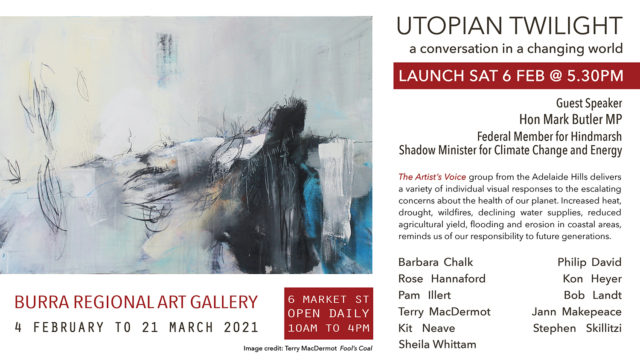
The Artist’s Voice group from the Adelaide Hills delivers a variety of individual visual responses to the escalating concerns about the health of our planet. Increased heat, drought, wildfires, declining water supplies, reduced agricultural yield, flooding and erosion in coastal areas, reminds us of our responsibility to future generations.
The aim of this exhibition is to continue drawing attention to this important conversation.
ARTISTS
Barbara Chalk, Philip David, Rose Hannaford, Kon Heyer, Pam Illert, Bob Landt, Terry MacDermot, Jann Makepeace, Kit Neave, Stephen Skillitzi and Sheila Whittam
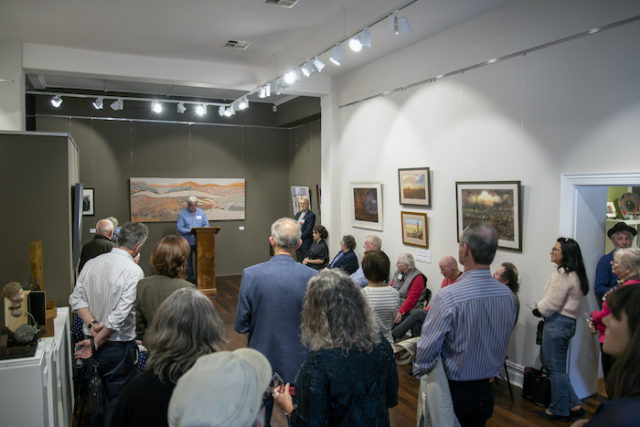
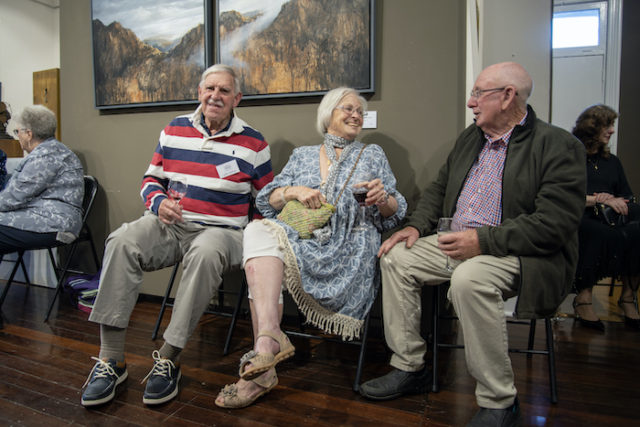
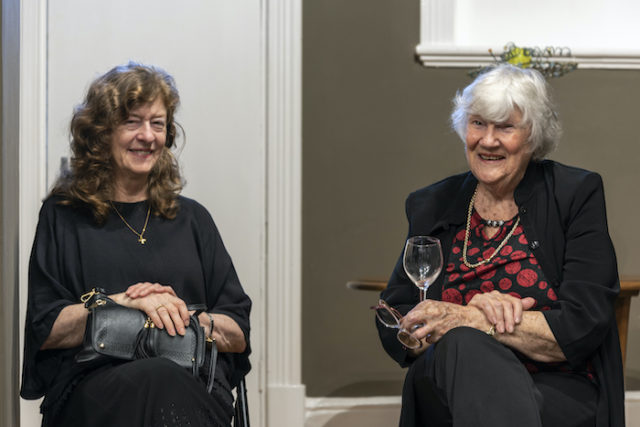
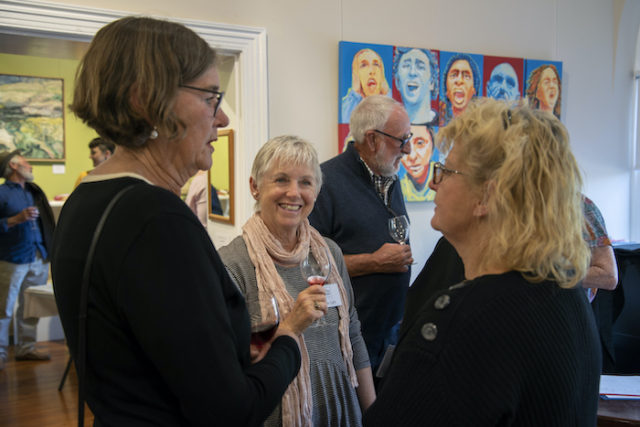
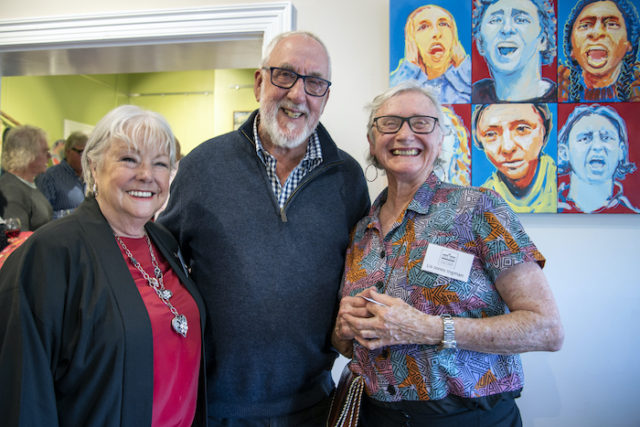
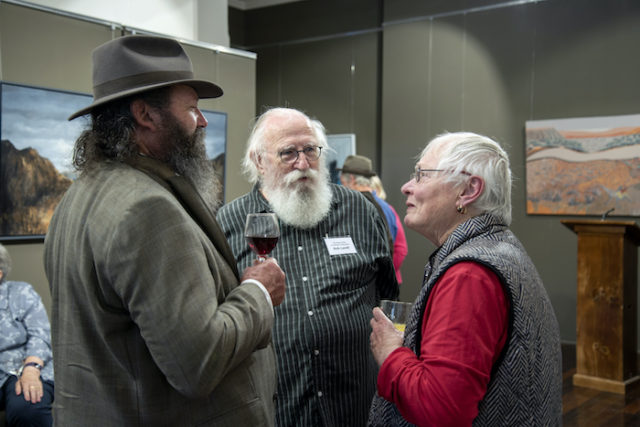
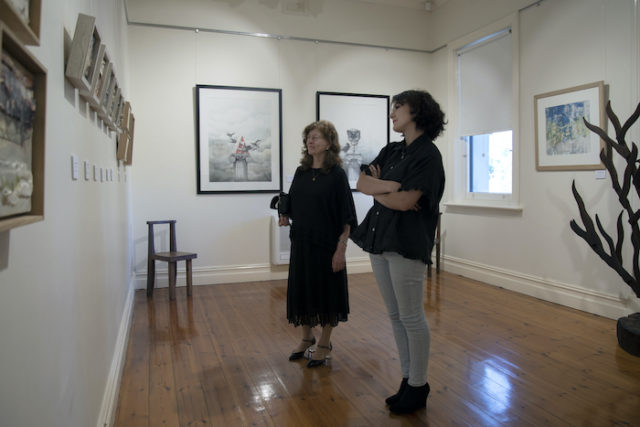

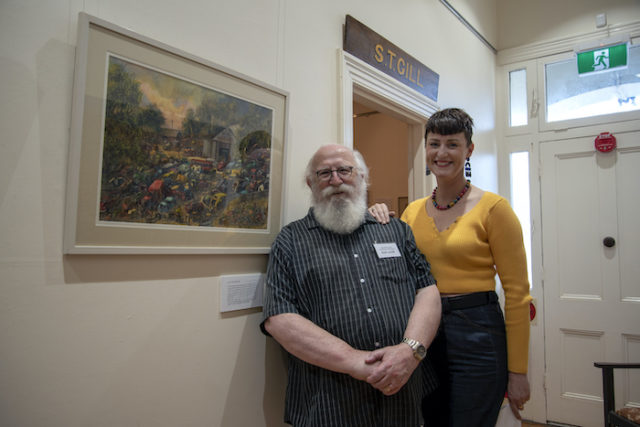
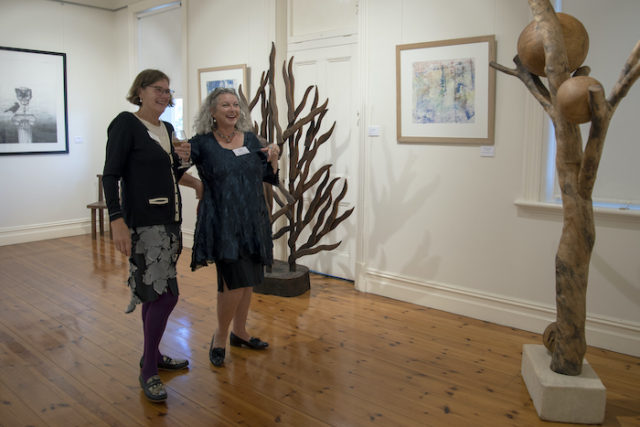
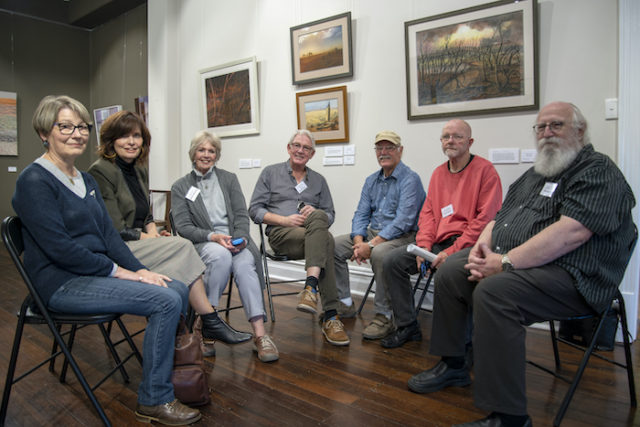
video by Sheila Whittam
OPENING SPEECH TRANSCRIPT
Acknowledgment of Country.
I acknowledge the Ngadjuri people as the Traditional Custodians of the land on which we meet, and recognise their continuing connection to land, water and community and pay respect to their elder’s past, present and emerging.
I also want to acknowledge the talented and passionate artists who made this exhibition possible. Many thanks to Terry MacDermot, Rose Hannaford, Kon Heyer, Jann Makepeace, Pam Illert, Barbara Chalk, Kit Neave, Sheila Whittam, Stephen Skillitzi, Philip David and Bob Landt. I particularly like the explanatory comments below the works because they’re so salient and pertinent Bob Landt says “There reaches a point when survival is no longer possible. This is when we are left with the STUMP of the story that once was.
Terry MacDermot says “We watch and wait. Anticipating change. I want action. Politicians want votes.
Everywhere I go, the mood for change is like a presence.
I’m sorry to say, Mark Butler is an apology for tonight, the recent reshuffle made it impossible for him to be here or find the time to even record a message of goodwill and encouragement which he has asked me to pass along to you all.
I should say this has been a heavy blow to the rank and file of the Labor Party, as Mark was a champion for strong action on climate change. The news was enough to make some think about laying down and giving up, a terrible outcome that must be resisted, because vacating the field means leaving it to the corporate barbarians and the amoral political serfs that do their bidding.
The great Muhammad Ali had a way to mentally prepare for heavy blows, he said, “A heavy blow takes you to the door of the half dream room, and when it opens, time slows down and you see neon lights flashing orange and green, bats blowing trumpets, alligators playing trombones and snakes screaming. On a rack near the door actors’ clothes are hanging and the task to survive is to slip on the costume, and act your way out until your head clears enough to get back in the fight”. A good tactic to keep in mind the next time a heavy blow jolts you.
Art sits above politics, its power and poignancy have an ability to catapult issues into the public consciousness like no other medium. With those opening remarks out of the way I’ve put some words together that I hope will do justice to the size of the climate challenge, the work and efforts of these wonderful artists, and to also provide reasons hope based on historical precedent.
It was the best of times, it was the worst of times, it was the age of wisdom, it was the age of foolishness, it was the epoch of belief, it was the epoch of incredulity, it was the season of Light, it was the season of Darkness, it was the spring of hope, it was the winter of despair……
That was from A Tale of Two Cities written in 1859 by Charles Dickens
Dickens was referring to Paris and London during the French Revolution. The revolution was a “spring of hope” for the mass of people who wanted action and relief from stifling poverty and oppression, however, for those of the ancient regime the revolution was a “winter of despair” which led to death and destruction. The phrase has great literary value in comparing and contrasting extreme situations.
The world is once again in an extreme situation. There are many threats to overcome, nuclear war, militarism, inequality, authoritarianism and a political system that vomits up ineffectual leaders. All of these issues can be challenged and overcome, but if the threat of climate change is not tackled soon then those issues become moot.
Recently the Actor Sean Connery passed away. In 1979 he made a movie called Meteor and played the role of Scientist Dr. Paul Bradley. He said to a group who had the power to mitigate the impact.
“I told you what’s gonna happen when that meteor hits! If you think you can prevent it by burying your heads under a blanket of shit,… fine… If you reach a decision, I’ll be in the bar across the street”.
In the film the name of the meteor was Orpheus. On June 23, 1988, ironically in sweltering heat, Dr James Hansen gave evidence to a US senate committee warning us about a metaphorical meteor called “Greenhouse Effect” that had already struck;
”It is time to stop waffling so much and say that the evidence is pretty strong that the greenhouse effect is here.”
Scientists warned us what was going to happen too, when they first expressed concern about possible climate change more than a decade before Hansen’s testimony. The most-publicized report came from the National Academy of Sciences in 1977. It warned that on current trajectories average temperatures may rise 6 degrees Celsius by 2050 due to the burning of coal.
It’s been more than 30 years since Hansen gave his evidence and we’re still collectively sitting in the bar across the street waiting for a decision, while our supine governing class still has their head stuck under a blanket of shit. At the COP 21 in Paris, it was acknowledged that 2 degrees of warming was too much and 1.5 was adopted in the text, but it wasn’t binding, it was left to nations to individually come up with their own response to meet the meaning of the text. The problem is when you add up all the individual solutions, the warming adds up to about 4 degrees. The following COP 22 held in Marrakech virtually folded on the news of Trumps victory together with his coterie of radical climate denying jihadi’s, known as republicans. Biden has taken the step of restoring the Paris agreements.
However the scale and dimension of the problem remain and are like nothing we’ve ever encountered. While 98 % of climate scientists agree climate change is real and happening, there’s another group within the 98% who think it’s much worse. The ice break up is so rapid they can’t model it and this group factor into the mix the 100 times more powerful gas methane, which makes the equation of “much worse”. Sobering facts are everywhere, let’s take just one, there’s about 5 gigatons of methane currently in the atmosphere, yet buried in the Siberian Arctic Shelf are thousands of gigatons of methane and if just 1% of that leaks into the atmosphere we’re looking at what they call abrupt climate change. British scientist John Nissen, chairman of the Arctic Methane Emergency Group, suggests that if the summer sea ice loss passes “the point of no return,” and “catastrophic Arctic methane feedbacks” kick in, we’ll be in an “instant planetary emergency.
That raises the question. Will the species survive?
The image that comes to mind is of the proverbial lemmings marching towards the cliff, while cheering their intrepid leaders. Julia Gillard, Australia’s first female Prime Minister put a price on Carbon that very quickly had positive effects effects. This was quickly removed by Australia’s first Moron as PM, Tony Abbott. Abbott regards climate change as “bullshit” and while he’s gone the legacy continues. I recently had a Facebook stoush with Craig Kelly MP, who is of the opinion that carbon dioxide doesn’t cause human health problems. So I invited them to put a plastic bag over his head, tie it tightly around his neck and see what happens next.
For the first time in history, humans are poised to destroy the prospects for decent existence and much of life. The rate of species destruction right now is at the level of 65 million years ago when a huge asteroid hit the earth, ended the age of the dinosaurs and opened the way for the proliferation of mammals. The difference is today, we are the asteroid, and we may be paving the way for beetles and bacteria when we’ve concluded our work.
No literate person can fail to detect that we are facing an era of severe environmental disaster and it could become dire if current tendencies are not reversed.
To give another example, a few years ago two leading scientific journals published a study of the west Antarctic ice sheet, its long been understood that if it collapses it will lead almost inevitably to a rise in global sea level of at least 10 feet within a few generations and wipes out civilization in any recognizable form. Studies show it is collapsing and leading scientists warn that further release of greenhouse gases will certainly make the situation worse destabilizing other parts of Antarctica as well as the Greenland ice sheet causing many of the world’s coastal cities to be abandoned with horrifying consequence for the poor inhabitants of coastal plains and probably millions in Bangladesh alone, which consequently will make the current refugee crisis look like a picnic.
There was a debate some years back between the astro-physicist Carl Sagan and Ernst Mayr, the grand old man of biology. The topic was the possibility of extra-terrestrial life, with Sagan saying from the point of view of an astro-physicist it’s very likely because there are so many planets similar enough to earth that they could sustain life and evolution to higher intelligence.
Ernst Mayr took the opposite view arguing as a biologist, he said we should pay attention to the one example we have, namely Earth and he pointed out that the history of life on Earth. There had been several billion species, some successful some not, and it turns out the success of a species in terms of its ability to survive is inversely related to its intelligence. So the most successful species are those that mutate very quickly, like bacteria or those that have a fixed ecological niche, like beetles, they do very well no matter what happens and as you move up the scale of what we call intelligence survival becomes much more hazardous.
Mayr also pointed out that the average life expectancy for a species is roughly about 100,000 years, ominously that’s about how long homo-sapiens have been on Earth. So Mayr’s conclusion is intelligence is basically a lethal mutation, as you move up to greater intelligence there’s more and more self-destruction and a Martian watching us from outer space might observe that we’re trying to prove Mayr correct.
The survival of the species is an open question, it all depends on what we do, meaning will the great mass of us enter the political sphere and demand a system that implements policies that the mass of humanity wants or will they let the self-interested dictums of the corporate mega rich, the 0.1% of the population continue to lead us down a path where environmental or nuclear oblivion is a real and present possibility. On January 26th each year, Australia Day, the atomic bulletin of scientists updates the Doomsday clock. When it started in 1947 it was at 7 minutes to midnight and with advent hydrogen bomb testing it went to two minutes to midnight in 1953, on January 26 2018 the clock returned to 2 minutes to midnight for the second time. This year, as last year the minutes were abandoned for seconds and at 100 seconds to midnight we are the closest we have ever been to catastrophe.
So, there’s plenty to be pessimistic about but plenty to be optimistic about too. For example, there’s now a problem about maintaining social security that’s been the subject of vicious attacks from the jackboot of austerity along with free education and free medical care. That wasn’t a problem in the 1920’s because there was no social security and no medical care. Even in the 1960’s there wasn’t a problem about defending medical care because there wasn’t any to defend and if you go through it case by case what you find is a gradual growth in civilisation and what occurs is a steady change that improves civil norms, it’s like a continuing upward recognition of intrinsic human rights that periodically gets beaten down and then the resistance starts again but from a higher level.
We’re at a higher level now than ever before. So, where’s it going to go next? Who knows, your guess is as good as anyone else’s? Nobody’s ever been able to predict it in the past and nobody’s able to predict now. What you can say is, yes, we’re back in another familiar period and it could lead to movements like in the 30’s or the 60’s or it could lead to fascism, nobody knows. Which way it goes depends on what people do, and these are not topics for academic seminars where you sit around and philosophise, it may be fun but it doesn’t make any difference what’s decided in those forums, because these are things that have to be answered in the arena of actual life, through action, participation, organising and the rest, that’s what will determine the answer and nobody can predict it.
I like the quote from Gramsci because it’s so germane to our times
“The crisis consists precisely in the fact that the old is dying and the new cannot be born; in this interregnum a great variety of morbid symptoms appear.” So, in the interregnum periods, it’s important to speak with a loud clear voice because when the time comes for the new, people look for the ideas that are lying around and what’s been advocated for.
Many of us feel as though we’re on a threshold of a future worth fighting for and we can feel that the tide of history is on the turn.
Many feel that the dark days which have lasted decades are coming to an end and that we can glimpse the sun beginning to rise. As George Harrison so memorably coined in his fabulous Beatle ballad, ‘Here comes the sun’ and if it finally does come up and fills the place with warmth and light, it won’t be because we hoped for it, it will be because people decided to enter the arena of actual life and demand things, because as Frederick Douglass told us on the 3rd August 1857, ‘Power never concedes anything without a demand. It never did and it never will.’
And on that note, I’m very pleased to say that the exhibition Utopian Twilight, a conversation for changing times is open.
Thank you
Russell Skinner
February 6th 2021
Burra Regional Art Gallery